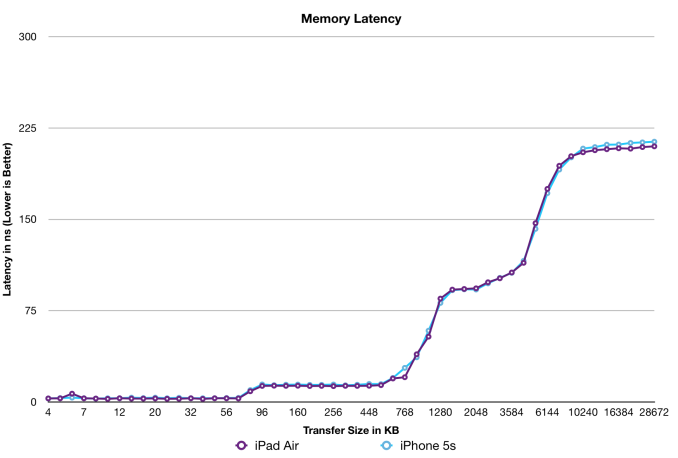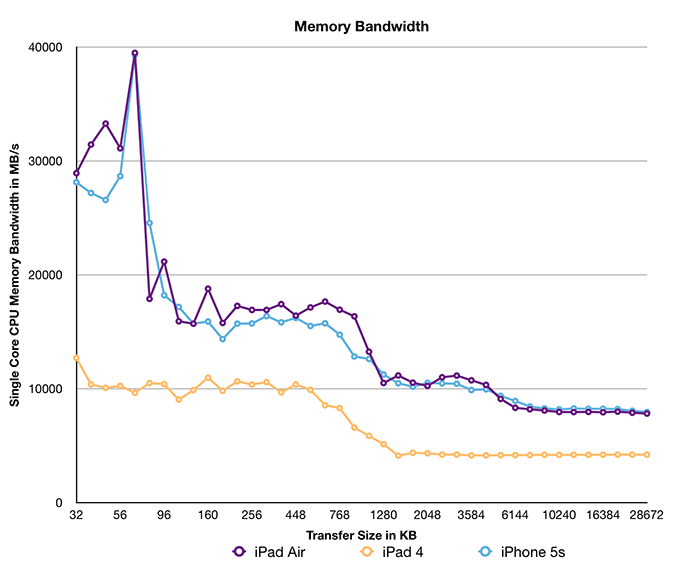The iPad Air Review
by Anand Lal Shimpi on October 29, 2013 9:00 PM ESTAn Update on Apple’s A7: It's Better Than I Thought
When I reviewed the iPhone 5s I didn’t have much time to go in and do the sort of in-depth investigation into Cyclone (Apple’s 64-bit custom ARMv8 core) as I did with Swift (Apple’s custom ARMv7 core from A6) the year before. I had heard rumors that Cyclone was substantially wider than its predecessor but I didn’t really have any proof other than hearsay so I left it out of the article. Instead I surmised in the 5s review that the A7 was likely an evolved Swift core rather than a brand new design, after all - what sense would it make to design a new CPU core and then do it all over again for the next one? It turns out I was quite wrong.
Armed with a bit of custom code and a bunch of low level tests I think I have a far better idea of what Apple’s A7 and Cyclone cores look like now than I did a month ago. I’m still toying with the idea of doing a much deeper investigation into A7, but I wanted to share some of my findings here.
The first task is to understand the width of the machine. With Swift I got lucky in that Apple had left a bunch of public LLVM documentation uncensored, referring to Swift’s 3-wide design. It turns out that although the design might be capable of decoding, issuing and retiring up to three instructions per clock, in most cases it behaved like a 2-wide machine. Mix FP and integer code and you’re looking at a machine that’s more like 1.5 instructions wide. Obviously Swift did very well in the market and its competitors at the time, including Qualcomm’s Krait 300, were similarly capable.
With Cyclone Apple is in a completely different league. As far as I can tell, peak issue width of Cyclone is 6 instructions. That’s at least 2x the width of Swift and Krait, and at best more than 3x the width depending on instruction mix. Limitations on co-issuing FP and integer math have also been lifted as you can run up to four integer adds and two FP adds in parallel. You can also perform up to two loads or stores per clock.
I don’t yet have a good understanding of the number of execution ports and how they’re mapped, but Cyclone appears to be the widest ARM architecture we’ve ever seen at this point. I’m talking wider than Qualcomm’s Krait 400 and even ARM’s Cortex A15.
I did have some low level analysis in the 5s review, where I pointed out the significantly reduced memory latency and increased bandwidth to the A7. It turns out that I was missing a big part of the story back then as well…
A Large System Wide Cache
In our iPhone 5s review I pointed out that the A7 now featured more computational GPU power than the 4th generation iPad. For a device running at 1/8 the resolution of the iPad, the A7’s GPU either meant that Apple had an application that needed tons of GPU performance or it planned on using the A7 in other, higher resolution devices. I speculated it would be the latter, and it turns out that’s indeed the case. For the first time since the iPad 2, Apple once again shares common silicon between the iPhone 5s, iPad Air and iPad mini with Retina Display.
As Brian found out in his investigation after the iPad event last week all three devices use the exact same silicon with the exact same internal model number: S5L8960X. There are no extra cores, no change in GPU configuration and the biggest one: no increase in memory bandwidth.
Previously both the A5X and A6X featured a 128-bit wide memory interface, with half of it seemingly reserved for GPU use exclusively. The non-X parts by comparison only had a 64-bit wide memory interface. The assumption was that a move to such a high resolution display demanded a substantial increase in memory bandwidth. With the A7, Apple takes a step back in memory interface width - so is it enough to hamper the performance of the iPad Air with its 2048 x 1536 display?
The numbers alone tell us the answer is no. In all available graphics benchmarks the iPad Air delivers better performance at its native resolution than the outgoing 4th generation iPad (as you'll soon see). Now many of these benchmarks are bound more by GPU compute rather than memory bandwidth, a side effect of the relative lack of memory bandwidth on modern day mobile platforms. Across the board though I couldn’t find a situation where anything was smoother on the iPad 4 than the iPad Air.
There’s another part of this story. Something I missed in my original A7 analysis. When Chipworks posted a shot of the A7 die many of you correctly identified what appeared to be a 4MB SRAM on the die itself. It's highlighted on the right in the floorplan diagram below:

A7 Floorplan, Courtesy Chipworks
While I originally assumed that this SRAM might be reserved for use by the ISP, it turns out that it can do a lot more than that. If we look at memory latency (from the perspective of a single CPU core) vs. transfer size on A7 we notice a very interesting phenomenon between 1MB and 4MB:
That SRAM is indeed some sort of a cache before you get to main memory. It’s not the fastest thing in the world, but it’s appreciably quicker than going all the way out to main memory. Available bandwidth is also pretty good:
We’re only looking at bandwidth seen by a single CPU core, but even then we’re talking about 10GB/s. Lookups in this third level cache don’t happen in parallel with main memory requests, so the impact on worst case memory latency is additive unfortunately (a tradeoff of speed vs. power).
I don’t yet have the tools needed to measure the impact of this on-die memory on GPU accesses, but in the worst case scenario it’ll help free up more of the memory interface for use by the GPU. It’s more likely that some graphics requests are cached here as well, with intelligent allocation of bandwidth depending on what type of application you’re running.
That’s the other aspect of what makes A7 so very interesting. This is the first Apple SoC that’s able to deliver good amounts of memory bandwidth to all consumers. A single CPU core can use up 8GB/s of bandwidth. I’m still vetting other SoCs, but so far I haven’t come across anyone in the ARM camp that can compete with what Apple has built here. Only Intel is competitive.












444 Comments
View All Comments
doobydoo - Friday, November 15, 2013 - link
The hardware in the HDX is slower, and it is finished in plastic. So which part was inaccurate?melgross - Wednesday, October 30, 2013 - link
There is no such thing as 100% RGB gamut. Which gamut are you talking about? sRGB? Adobe 1998 RGB? Pro RGB? There are a lot of RGB standards out there.Theard - Wednesday, October 30, 2013 - link
what Cindy implied I didn't even know that people can earn $6894 in four weeks on the computer. look at this site ... jobs23.comLizbeth - Sunday, November 3, 2013 - link
and is several price points less that the ipad airKrysto - Wednesday, October 30, 2013 - link
> is probably the higher clocked Z3770I don't see that in any tablets today, let alone smartphones. So don't say it like that, as if it's already happened. As it is, Intel's chips aren't very competitive, in both CPU and GPU performance.
> while Qualcomm will probably pass Apple's GPU early next year.
They are equal right now, at least in smartphones. The others, perhaps with the exception of Nvidia, don't really make separate "tablet chips". They make one chip for both smartphones and tablets.
Speedfriend - Wednesday, October 30, 2013 - link
"As it is, Intel's chips aren't very competitive, in both CPU"You obviously have a problem reading, given the Transformer T100 which is very close to the iPhone 5S and iPad Air in the benchmarks above, uses the Atom Z3740, which is only the second fastest. So the Z3770, which is clocked 33% higher, should be at least equal if not better than A7 in CPU benchmarks.
How in your mind that equates to not competitive I don't know..
Homeles - Wednesday, October 30, 2013 - link
Not to mention that a lot of A7's strength isn't in the silicon, it's in the software stack on top of it. All of the CPU benchmarks are done through the stock web browser -- that's something Apple can fine tune, while Intel cannot. Therefore, the A7 outperforming Atom doesn't point to Atom being weaker at a silicon level, and instead shows the advantages of being able to hand tune your OS and applications and squeeze more out of your hardware.raptorious - Wednesday, October 30, 2013 - link
I'll give you one reason: the fact that Anand omitted the iPad 4 from the latency graph in the "An Update on Apple’s A7: It's Better Than I Thought" page. Why is the iPad 4 in the bandwidth graph and not in the latency graph. I'll tell you why: because the iPad 4 has better latency and Anand doesn't want to make the A7 look bad, so he left it out. No bias? Right.syedjalalt - Tuesday, November 5, 2013 - link
Apple iPad is a great product. No doubt. The word selection for writing such important reviews has been good here. IF you go The Verge and see the iPad review, you will notice how biased and predictable they have become. Nilay Patel doesn't know anything. The guys @verge always mock Android and especially Samsung.Last year's Nexus 4's review score had 8 for camera and 9 for ecosystem(as far as I remember). This year, ecosystem is 8 and camera is 5. Great!!!1
doobydoo - Friday, November 15, 2013 - link
Yep it's ridiculous that the Nexus 4 got 8 for camera. Should have been 3/4.Ecosystem scores can vary over time so don't see the problem there. Android hasn't moved on much in the past year.